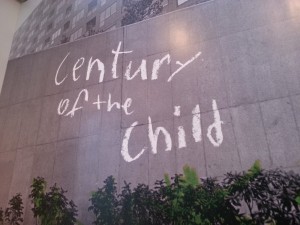As design constantly evolves to include not just artifacts and their designers, but processes, ideas and relationships, planning and executing an exhibition that traces a narrative of design history spanning a hundred years is no small task. Century of the Child: Growing by Design, 1900-2000, opened to both child and adult audiences alike this fall at the Museum of Modern Art (MoMA). Drawing on a hundred years of child-centered design, the exhibition was curated by Juliet Kinchin and Aidan O’Connor of the Department of Architecture and Design at MoMa. It borrowed heavily from Ellen Key’s writing in 1900 on what the role of progressive design would be in a child’s education and experience of a swiftly changing world in the coming century.
In remapping a history of design, the social, political and cultural events provides a platform through which the varied perspectives and visions of thinkers, designers and reformists translates into artifacts for the child- books, toys, furniture, schools and architectural models, clothes and homes. This exhibition informs and celebrates design history in the area of the development of the child.
Weaving its way through an entire century dedicated to the child, the exhibits have an archaic, ephemeral yet playful feel. The initial sections are light-hearted and engaging, depicting a welcoming of modernity in design in the early 1900s with an emphasis on the development of the child. The second half takes on a serious note exploring the changing contexts of child development with the onset and after effects of the World Wars. In ending with the century, design’s role changed in relation to the practices of mass production and consumption that is illuminated through examples of innovation through material, technique and concept.
The interesting aspect of this exhibition was in the manner that the artifacts were displayed. The exhibits and installations belonging to categories that traced the relatively recent developments in design were displayed openly on the walls, some in collaboration with videos and sound clips, at various spatial levels and some even in the middle of the room so as to be viewed from all directions. It attempts to engage the viewer because it exudes a sense of tactility that is associated with child’s play. On the other hand, the older exhibits belonging to the start of the century remained cold and unresponsive, being shielded in glass cases only to be viewed at from a distance. In portraying the history of design, the curators have adopted a retrospective position that also says a lot about how historical design artifacts are viewed in the present context.
In addition to this, an exhibition of this scale tends to lose its narrative now and then due to the sheer amount of information it yields to the viewer. In tracing the role of the child in modernity, the numbers of designers, designs and dates tends to overwhelm the viewer. However, in tracing a vast design history in great depth and on multiple levels, it reinforces the notion that design advocates change and is a powerful tool through which to do so. It is an overwhelming, informative experience because it manages to remind one of childhood, but overwhelm also in its serious retrospective view of the agenda behind design. It points to critical information in looking ahead at the new century to imagine the growth curve of design.
Further reading:
http://www.moma.org/interactives/exhibitions/2012/centuryofthechild/#/
http://tmagazine.blogs.nytimes.com/2012/07/23/serious-play-century-of-the-child/
Tags: Exhibitions
